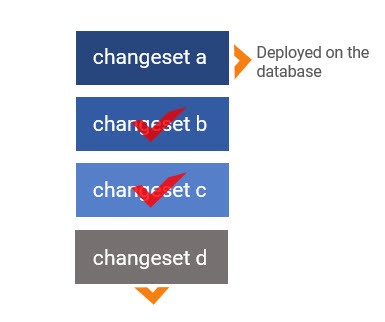update-count
Last updated: September 2, 2025
The update-count command sequentially updates a specified number of changesets on your database.
Uses
The update-count command is mainly used when you want to apply changes and update changesets sequentially, starting with the changesets from the top of the changelog file until the number specified is reached.
The image below shows four changesets: changeset a, changeset b, changeset c, and changeset d. As you can see, changeset a has already been deployed in the database. So, running the command update-count --count=2 deploys changeset a and c without applying changeset d.

Additionally, the best practice is to run the update-count-sql helper command because it allows you to inspect the update-count SQL, so you can correct any issues before running the command.
In Liquibase Secure 4.25.1 and later, you can automatically generate a database Update Report summarizing this command.
Syntax
To run the update-count command, specify the driver, classpath, and URL in the Liquibase properties file. You can also specify them from the command line.
Then run the update-count command:
liquibase update-count --count=2 --changelog-file=example-changelog.xml
Note: The --count=myCount syntax was added in Liquibase 4.4. If you use an older version, specify your count as a positional argument: <command> myCount.
* Liquibase will check nested changelogs for definitions of the changesets to update.
Note: The username and password attributes are not required for connections and systems which use alternate means of authentication. Also, you can specify database credentials as part of the url attribute.
Command parameters
Attribute | Definition | Requirement |
| The root changelog | Required |
| Integer specifying how many changes Liquibase applies the command to. Specify as | Required |
| The JDBC database connection URL. | Required |
| Fully-qualified class that specifies a | Optional |
| Path to a properties file for the | Optional |
| Specifies the changeset contexts to match. Contexts are tags you can add to changesets to control which changesets are executed in any particular migration run. Note: If you use Liquibase 4.23.0 or earlier, use the syntax | Optional |
| Name of the default catalog to use for the database connection | Optional |
| Name of the default schema to use for the database connection. If Note: In the properties file and Note: In Liquibase 4.12.0 and later, you can use mixed-case schema names if you set | Optional |
| The JDBC driver class | Optional |
| The JDBC driver properties file | Optional |
| Liquibase Pro only. Use this argument only if you are specifying | Optional |
| Specifies the changeset labels to match. Labels are tags you can add to changesets to control which changesets will be executed in any migration run. | Optional |
| Password to connect to the target database. | Optional |
| Enables a report at the command level. Overrides the global parameter | Optional |
| Specifies the name of the report file at the command level. Overrides the global parameter | Optional |
| Specifies the file path to the report file at the command level. Overrides the global parameter | Optional |
| Liquibase 4.31.0+. Specifies whether to hide exceptions (which may contain SQL) from the operation report at the command level. Overrides the global parameter If If | Optional |
| Liquibase 4.31.0+. Specifies whether to hide changeset SQL in operation reports at the command level. Overridden by the global parameter | Optional |
| Liquibase Pro only. If any changeset in a deployment fails, Note: A changeset marked | Optional |
| Liquibase 4.24.0+. Produces a summary list of any changesets skipped and why they were skipped. Valid values are Note: Liquibase may display one or multiple reasons for halting deployment of a changeset. If Liquibase cannot resolve a halting reason, it does not evaluate the changeset for other possible halting reasons. | Optional |
| Liquibase 4.24.0+. Summary output to report the updated summary results. Valid values are | Optional |
| Username to connect to the target database. | Optional |
Liquibase Version: 4.9.1
Liquibase Community 4.9.1 by Liquibase
Liquibase command 'update-count' was executed successfully.